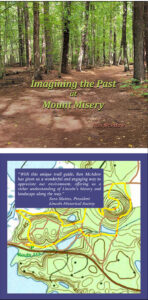How did Mount Misery get its name? Who built the 350-year-old sawmill? What forces shaped this strange, eventful, terrain? These are some of the questions answered in Imagining the Past at Mount Misery, a new booklet by Lincoln resident Ron McAdow.
The book offers a trail guide to the Mount Misery conservation land with color photos, maps, and diagrams explaining the history and geology along a two-mile walk on the property. McAdow lives near the trails and walks then frequently, “and I discovered this land had an unexpectedly fascinating history,” he said. That part of Lincoln was originally in Concord, and in the century before Lincoln was incorporated in 1754, the Billings family, and their sawmill and farms, were part of Concord’s history. After doing research at the Concord and Lincoln libraries and online, “I invited friends for a walk, and told them what I’d learned. They found it interesting and encouraged me to write it down.”
McAdow was executive director of Sudbury Valley Trustees from 2003 to 2013. Before that, wrote guides for paddling local rivers, with one book on the Concord, Sudbury, and Assabet Rivers and its follow-up, Charles River: Exploring Nature and History on Foot and by Canoe. For the Appalachian Mountain Club, he also co-authored a book called Into the Mountains; the Stories of New England’s Most Celebrated Peaks. More recently, he’s been writing fiction, and he’s also editor in chief at Personal History Press, where he formats and ghost-writes family memoirs for clients.
“I began [the latest book title]with the word ‘imagining’ because if you use your imagination on this walk, at some points you’re on an island overlooking a huge frigid lake, while at other times you’re walking along the bottom of a what was a lobe of ice, looking up at sand and gravel deposited by meltwater streams as the last ice sheet melted,” McAdow said. “If you go back only 350 years, you can help an English immigrant and his sons try to figure out how to scratch a living from the sand the glacier left behind. It grows pine trees well enough; how are they to be converted to lumber, and how are those boards to be transported to market? We don’t have precise information about these topics — but we can fill in, provisionally, by imagining the needs of the people who lived here. When we stand on the top of Mount Misery we know for sure what Henry Thoreau’s impressions were, when he had climbed that hill, because he recorded them in his journal.”
In writing this kind of guide, “recreation meets education. It can’t be a tome, but it needs enough of the right details to be interesting,” he said. “The challenges start with locating information, then sorting what’s plausible from what seems to be mistaken and verifying or correcting conclusions with people who know more about local history than I do. I appreciate the assistance of the Lincoln Historical Society! The next challenge is to figure out a format that will suit the purpose. I had just completed a square color book about a family farm for a client of my Personal History Press. I thought it was attractive and flexible format, so I used it for the guide. Balancing space given to different subjects and choosing visual materials is fun but not easy.”
McAdow will give an online slide talk about the project at the monthly Conservation Coffee hosted by Lincoln Land Conservation Trust and Rural Land Foundation on Thursday, Dec. 2; call 781-259-9251 or email llct@lincolnconservation.org for details. Imagining the Past at Mount Misery is available at Something Special in Lincoln and Verrill Farm in Concord; his other two books are available at the Mass Audubon Shop at Drumlin Farm and Sudbury Valley Trustees’ Wolbach Farm.


Leave a Reply